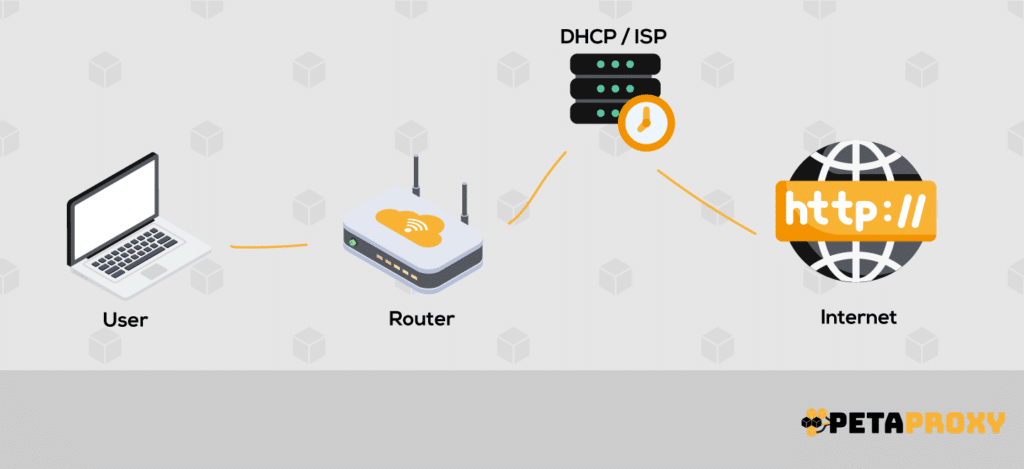In today’s linked world, where devices often move within networks or don’t have a set function like printers or scanners, dynamic IPs have become very common. If you don’t often connect to private networks or home computers, the fact that your device’s IP address changes may not be a big deal. A changeable IP address is usually given to you by your ISP’s DHCP server as soon as you connect to the internet. In home or business networks, routers often give temporary devices changeable IP addresses.
It makes sure that resources are used efficiently, just like a dynamic IP address changes to meet the changing needs of your network. Dynamic IPs are more flexible than static IPs, which stay the same. This is because today’s networked gadgets are always changing.
What is a Dynamic IP Address exactly?
A Dynamic Host Configuration Protocol (DHCP) router gives a device a dynamic IP address instead of a static IP address that has to be set up by hand. Because dynamic IPs are temporary and can change, they give network managers more options and better use of resources. When a device connects to the network, it sends a request to the DHCP server. The DHCP server then dynamically assigns available IP numbers to devices, avoiding conflicts and making sure communication works smoothly.
You can really benefit from this dynamic allocation in places where devices join and disconnect often, like offices or homes with lots of users and devices. The process makes the best use of shared network resources so that IP numbers don’t run out. In contrast to static addressing, dynamic IP addressing changes with the network, which makes it a useful and efficient choice for most situations.
How a Dynamic IP Address Works ?

A static IP address stays the same for one device, but a dynamic IP address changes over time, offering users a name that changes all the time online. The Internet Assigned Numbers Authority (IANA), a worldwide group, is in charge of making sure that IP numbers are given out correctly. Five companies make up regional internet registers (RIR), which are the first link in the chain. They send out the information. The next group is local records (LIR). Keep in mind that LIR includes big ISPs and telecom service providers, which gives them a lot of control over the IP number pool.
ISPs carefully keep track of everything their users do, even when they give out addresses on their networks without connecting them permanently to a client. There is a list of IP addresses that were used as well as information about the users, the times and places of the contacts. If you want to get around in a world where IP numbers change, you need to know about these changes.
When a Dynamic IP Address is needed ?
Most internet service providers (ISPs) give out dynamic IP addresses by default. They are the most popular and flexible type.
People who use the internet every day like dynamic IP addresses because they are easy to control. These addresses don’t need any extra setup or complicated network settings, which makes them the best choice for easy online navigation. Organizations and home networks that want easy-to-use solutions find that dynamic IPs are great for managing their networks well.
In contrast to their static peers, dynamic IP addresses are more cost-effective. They don’t cost anything extra, so they’re not only a good option, but also a cheap one. The problems caused by static IP addresses, which have a fixed number because they are 32 bits, are largely fixed by the dynamic allocation method, which uses a pool of addresses that are always changing.
In addition to being useful and saving money, security is another reason why dynamic IP numbers are a good idea. The fact that these addresses are always changing adds a layer of complexity, which makes them less predictable and more resistant to possible threats.
It’s clear that connectivity options that do more than just meet the minimum requirements are possible when they use dynamic IP addresses. If you use the internet for fun, work for a company, or are just getting around in the digital world, picking a dynamic IP address isn’t just about sticking to the usual settings; it’s about planning your connectivity to meet the practical needs of an ever-changing online world.
Dynamic vs Static IP: Whats the Difference

You can choose between dynamic and static IP addresses. This is a basic choice that affects how machines in a network talk to each other. What makes each method different is that it offers different benefits depending on the needs of the network infrastructure. This study delves into the complexities of dynamic and static IP numbers, revealing how dynamic IPs change automatically and how static IPs stay the same over time. It is very important for network managers to understand the differences between these two addressing methods because they affect how well, easily, and reliably a network works.
Let’s look at what makes dynamic and static IP´s different:
Key Characteristics of Dynamic IP´s
- Automatic Assignment: A Dynamic Host Configuration Protocol (DHCP) server gives devices dynamic IP numbers without them having to do anything. When a device joins to the network, it asks the DHCP server for an IP address. The server then chooses an available address from a pool of addresses that have already been set up. This automation makes setup easier because devices don’t need to be set up by hand, which is especially helpful in big networks.
- Temporary: Dynamic IP numbers are only good for a certain amount of time and are leased. The DHCP server gives the device a lease time during which it can use the IP address it was given. The device must renew the lease with the DHCP server when the term ends. This dynamic leasing method makes it easy to handle IP addresses and keeps unused addresses from being locked up for a long time.
- Flexibility: Dynamic IP addressing is very adaptable, which makes it perfect for places where many devices join and disconnect at different times. The DHCP server changes how IP numbers are assigned to devices as they join or leave the network. This makes sure that each device gets a unique address and there are no conflicts.
- Resource Optimization: The DHCP server handles the dynamic allocation process, which keeps address problems from happening and makes the best use of resources. This makes sure that the pool of IP addresses is used properly, so that the pool doesn’t run out when a lot of devices are using the same network infrastructure.
- Ability to adapt: Dynamic IP addressing can change as the network environment does. This ability to change is very important in settings where the network’s configuration changes over time. Because dynamic IP assignment is routine, it makes it easier to add new devices and change how the network is set up when needs change.
Key Characteristics of Static IP´s
- Manual Configuration: Static IP addresses are set up by hand for each device, unlike changing IP addresses. When network managers give a device an IP address, that address stays the same until it is changed by hand. This manual setup gives each device on the network a unique identifier.
- Permanent: Static IP addresses don’t change unless you change them on purpose. Because they don’t change, they can be used for things like servers, routers, and network infrastructure parts that need a permanent identifier. It makes sure that services and apps that need a set IP address can connect and stay connected.
- Cases: Static IPs are often better in certain situations where you need a stable and reliable identity. Static addressing is usually good for servers, network printers, and other important parts of the network infrastructure. It makes sure that service doesn’t go down and makes managing the network easier.
- No Dynamic Allocation: The DHCP server dynamically assigns dynamic IPs, but static IPs don’t go through this process. Because each device keeps the IP address that was manually given to it, static addressing is less useful in environments where the configurations change often.
Note: To sum up, the choice between dynamic and static IP addresses relies on what the network and its devices need. Dynamic IPs allow for automation, flexibility, and efficient resource use. Static IPs, on the other hand, offer stability and a set identifier, making them perfect for certain devices and applications.
How to Rotate Your IP Address?
Now that we’ve talked about how dynamic IP address selection and control work, there is one more question that stays with us: can you change your IP address?
Changing your IP address is a powerful idea that can help you protect your privacy online and find your way around more effectively. This method is different from the usual ones, and it lets users improve their online privacy, get around restrictions, and fine-tune their online appearance.Learn more about the details of IP rotation to open up a world of options in the vast digital world. Mastering IP rotation is essential whether you want to improve your privacy, get around geographical limits, or just make the most of your online presence.
Importantly, when the usual ways your internet service provider gives you don’t work, a unique option appears: using rotating mobile proxies. As flexible middlemen, these proxies offer a wide range of IP addresses that can be used in different situations. This keeps your online identity private and flexible. Find out the strategies and tools that will help you take charge of your online story, even when normal methods don’t work. If you’re brave enough, you should try IP rotation, a unique and strategic method that will change the way you connect with the endless possibilities of the internet.
Conclusion
In a world where everything is connected and digital interactions are always changing, dynamic IP addresses play a bigger part than usual. Dynamic IPs are an important part of modern connectivity because they make it possible to change to different ways of using the internet and are also cheap and safe. The choice between dynamic and static IPs is a key one that affects how quickly, reliably, and safely network interactions work. As we move through this range of connectivity options, the dynamic IP becomes not only the usual setting but also a strategic choice that helps us keep up with the changing needs of the online world.






